AMD's Radeon HD 6790: Coming Up Short At $150
by Ryan Smith on April 5, 2011 12:01 AM ESTPower, Temperature, & Noise
Last but not least as always is our look at the power consumption, temperatures, and acoustics of the Radeon HD 6790. Our power usage data should closely mirror any other 6790, but given the unique design of our card versus what AMD’s partners are going with, we can’t fully account for all the different designs.
On that note, at this point we do not know what the 6790’s default voltage is. None of our usual low-level tools recognize the 6790; it’s possible that AMD is using different controllers than on the 6800 series, or perhaps it’s related to drivers. In any case we believe it’s close to the 6870’s voltage of 1.17v, but we can’t measure it at this time.
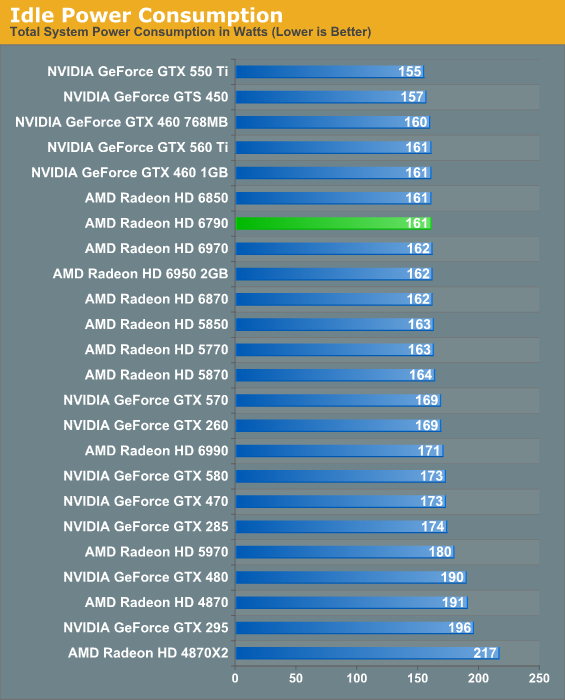
Idle power consumption rarely changes among the different tiers of a GPU, so the fact that the 6790 pulls almost as much power at idle as the 6800 series should not come as a surprise. It does end up being worse than the GTX 550 Ti, but almost exactly alike the GTX 460.
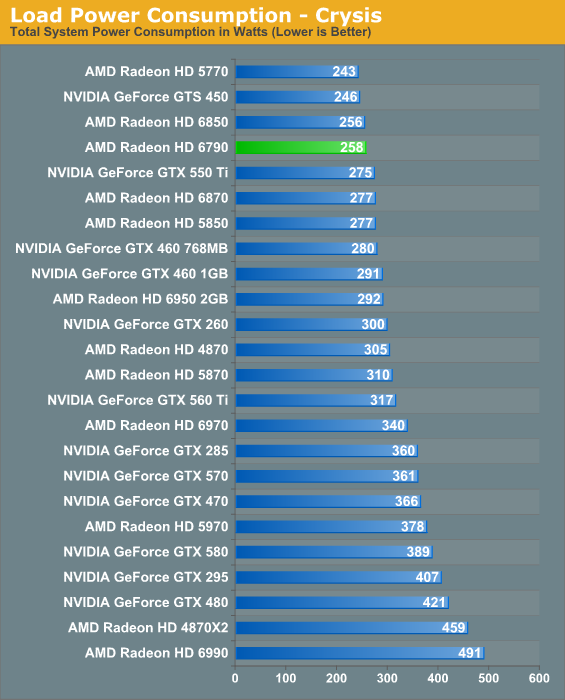
Given AMD’s TDP numbers, we were expecting our power results to closely shadow our 6870 results. Instead we had a pleasant surprise: power consumption under Crysis is higher than the 6850, but not significantly so. In fact it’s still below the GTX 550 Ti even though it significantly outperforms said video card on this game, and even compared to the 5770 it’s not significantly worse for the 6790’s performance advantage. Not that it’s great to be consuming more power than a 6850 for less performance, but it could very well have been worse.
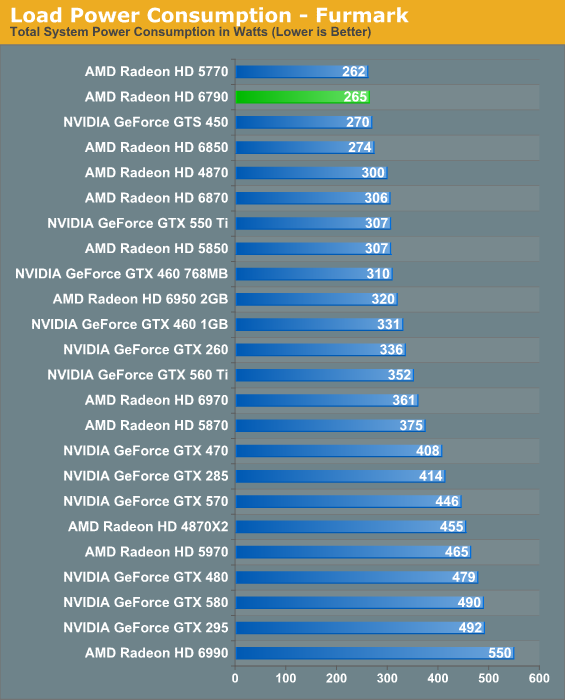
The situation under Furmark is even better surprisingly enough. The 6790 consumes less power than the 6850 here – not a ton less, but less. Perhaps more surprising is that compared to the 5770 it’s only consuming 3W more; this Barts chip may have a lot of functional units disabled, but that’s still quite remarkable, and is all the more proof of the optimizations AMD made for Barts compared to Cypress. This also makes it look exceptionally good versus the GTX 550 Ti and GTX 460 768MB, as it’s consuming 40-45W less.

With idle power consumption being identical to the 6800 series and using the same cooler, the idle temperature is similarly close.
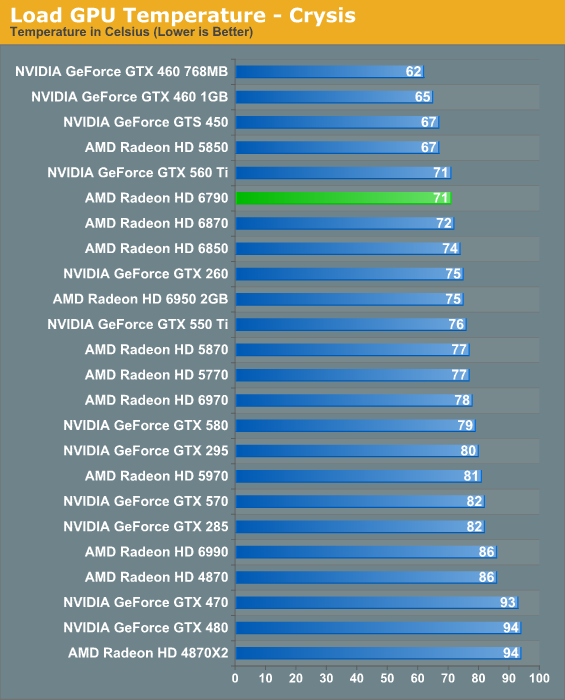
Given the power numbers we saw earlier, the 6870’s cooler ends up being overkill for the 6790. As a result Crysis temperatures are quite low, although the fully exhausting cooler can’t keep up with the open cooler of the GTX 460. Then again our 5770 is an open cooler, and it’s still much warmer. Keep in mind that this is going to highly vary with the design of the cooler the partner uses though.
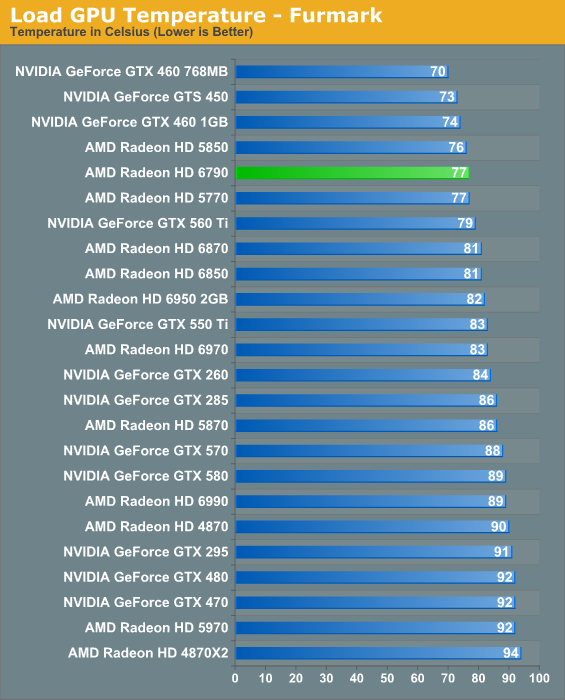
Temperatures under Furmark closely trend Crysis. An open cooler might be able to get the 6790 down to the low 70s.
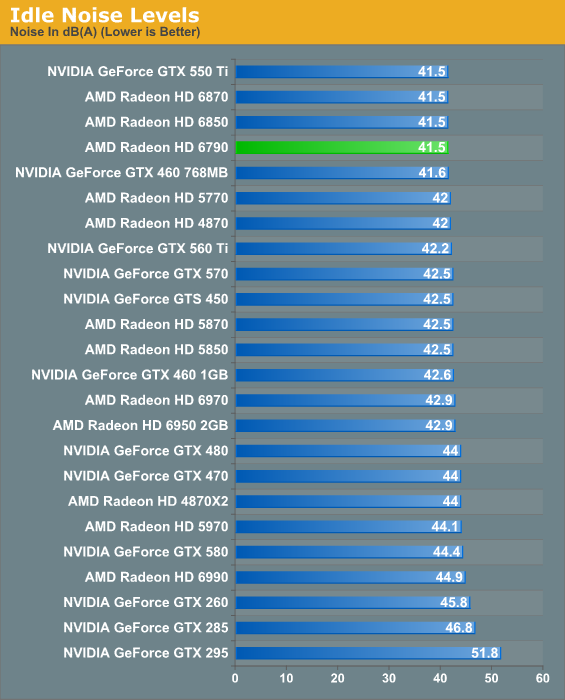
Idle noise is identical to the 6800 series, as we’d expect.
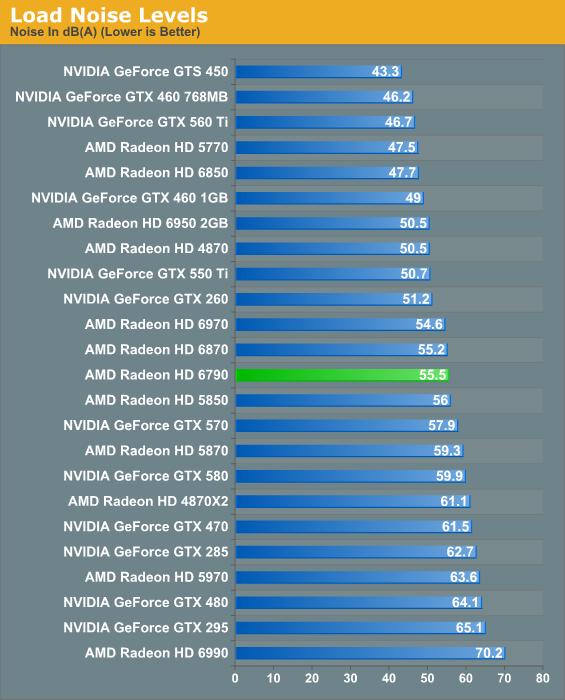
Load noise is where the wheels begin to fall off on our 6790 sample. The card does so well with regards to power consumption and temperature, but noise is just as bad as the 6870. This undoubtedly is due to how AMD tweaked the 6790 engineering sample – which is to say it likely hasn’t been optimized much if at all since it won’t go into production. Given the power data we’ve seen the 6790 doesn’t need to be much louder than a 6850, so hopefully partner cards will reflect this. If not, the worst case scenario may very well be having all the noise of a 6870 and not nearly the performance.










69 Comments
View All Comments
geniekid - Tuesday, April 5, 2011 - link
Tom's used a higher end card paired with the 6790 to test the Crossfire performance of this thing. The results suggest there might be some value to this card if used in Xfire configuration compared to single cards around the same price. It would be nice to explore that possibility!BPB - Tuesday, April 5, 2011 - link
I have been happily running with two HD4850's for a few years now, and want to upgrade. It seems to me that if I stick to a 24" 1920x1200 monitor practically any card will do. Still, I don't like the idea of getting a 6800 series since it's practically 2+ year old technology. Wondering if I should go 6900 series, or wait till 7000 series. Come AMD, man up, put some real upgrades out there that make it easy for me to decide.richardginn - Tuesday, April 5, 2011 - link
it is nice to see a review the AMD 6790 video card, but how about a review of the AMD 6450, AMD 6550, and AMD 6670 OEM video cards???jabber - Tuesday, April 5, 2011 - link
Arent they just the 5XXX cards re-branded with a 6? If so a waste of time.Plus as they are OEM we wont be buying them.
richardginn - Wednesday, April 6, 2011 - link
Actually no. These OEM cards are very different.The 6450 video card which I have only seen sold as an option at HP.com is supposed to be like twice as fast as the 5450 based on the specs listed from the AMD website.
If you are talking just a rebranded video card you have to be talking about the OEM 6770 and 6750 video cards which have no performance boost in the FPS area.
Will these cards go off OEM status when Bulldozer CPU'S are released or just move on to something like a 7450 video card????
Ryan Smith - Tuesday, April 5, 2011 - link
Funny you should mention that...BoFox - Tuesday, April 5, 2011 - link
Is the memory bus really 128-bit instead of 256 bits wide? I'm wondering why Anandtech put a lot of effort into checking up on GTX 550 Ti's 192-bit bandwidth with an odd number of chips, but not on either the 5830 or 6790 that claims 256-bit bus while the ROPs are cut in half.We all know that the number of ROPs is tied with the memory bus for a given architecture design. This is why NV's GTX 550 Ti seems much more valid, as it is linear with 24 ROPs.
If we look at the 5830 here:
http://techreport.com/articles.x/18521/5
3D Mark Vantage color fill test is strongly correlated with the memory bandwidth. If the 5830 were 256-bit, it would have had identical bandwidth with 5850. However, the performance shows that it is not the case. It is barely half of 5850's performance, and also much slower than HD 4870 which has only 16 ROPs at a lower clock than that of 5830.
Next, if we look at BeHardware's ultimate scrutiny (just as respectable as Anandtech's examination of GTX 550 Ti): http://www.behardware.com/articles/783-3/preview-r...
We see that the 5830 has far lower FP16 and FP32 GPixel/s writes than not only the 5770 that has a slightly higher fill rate, but also the 4890 to a far greater degree. The test is directly linear to the available bandwidth as the 4890 is so much faster than the 5770, let alone 5830 in that respect.
One more thing is that as with Barts architecture, we should all know that it is based on VLIW4 architecture, not the traditional VLIW5 one. It seems that AMD wanted to save the "thunder" for Cayman's launch by reserving the announcement for what desperately needed as much thunder as possible. Just look at how close 6870's performance is to 5870 while comparing 6870's 1120sp and 4.2Gbps bandwidth to 5870's 1600sp and 4.8Gbps bandwidth.
Hope you guys enjoyed a little bit of exposure! Is AMD deliberately giving us wrong information? That's not my problem, but if I were the one reviewing the product, I would definitely point these things out in my article.
Ryan Smith - Tuesday, April 5, 2011 - link
From a graphics point of view it's not possible to separate the performance of the ROPs from memory bandwidth. Color fill, etc are equally impacted by both. To analyze bandwidth you'd have to work from a compute point of view. However with that said I don't have any reason to believe AMD doesn't have a 256-bit; achieving identical performance with half the L2 cache will be harder though.And Barts is VLIW5, not VLIW4. Only Cayman is VLIW4.
BoFox - Tuesday, April 5, 2011 - link
Barts is also Northern Islands--the keynote of the architecture being VLIW4.See, the 6790 wouldn't come within 2-3% of 5830 according to all of the benchmarks at the review here.
If it were VLIW5 like the 5830, the 6790 would've been MUCH slower (or the 5830 much faster).
This is because HD 5830 has 1120sp, which is 40% more than 6790's 800sp. It also has 56 TMU's, which is 40% more than 6790's 40 TMU's.
All of the other specs are shockingly similar, with only 5% difference in core and memory clock speeds. Both the 5830 and 6790 have the same "alleged 256-bit bus".
In spite of the whopping 40% shader and TMU difference, the 6790 comes SO close to the 5830--close enough that it's only possible if the 800sp were VLIW4 (multiply it by 5/4 and you get performance like 1000sp). It would only make sense there, as 1000sp is about 10% less than 1120sp, but with 5% higher clock, it comes to within 2-3% of 5830's performance.
If not for VLIW4, what would it be? Tell me.
BoFox - Tuesday, April 5, 2011 - link
Typo: I forgot to add "if it weren't for VLIW4" before the second sentence above. Sorry if it's confusing.Shouldn't we all already know that Barts XT was of the Northern Islands VLIW4 architecture from how close it was to the 5870 (1120sp vs 1600sp which is 43% higher)? Even after adjusting for the clock differences, the shader/TMU operations per second is still 35% higher for the 5870, yet the 5870 turned out to be only 9% faster overall. It would've made perfect sense if Barts XT had 1400 VLIW5 shaders (using the 5:4 ratio over 1120sp).
Using the math: 1600sp x 850Mhz is ... 8% faster than 1400sp x 900MHz. The memory bandwidth does not affect the performance too much since the proportion of bandwidth to GPU muscle is not changed by much. So, it's really close to the overall 9% actual performance difference between 5870 and 6870. Is that coincidental? The reason the difference is actually greater than the calculation is because 1120sp VLIW4 does not exactly translate to 1400sp VLIW5. VLIW4 is not perfectly efficient as to scale 100% at a 5/4 ratio, but it's pretty close.
What else would it be, sincerely?